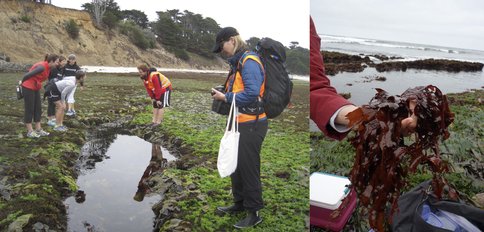2015 Annual Science Report
 VPL at University of Washington
Reporting | JAN 2015 – DEC 2015
VPL at University of Washington
Reporting | JAN 2015 – DEC 2015
The Long Wavelength Limit of Oxygenic Photosynthesis
Project Summary
Oxygenic photosynthesis (OP) produces the strongest known biosignatures at the planetary scale on Earth: atmospheric oxygen and the spectral reflectance of vegetation. The pigment chlorophyll a was long considered the unique controller of both of these biosignatures, in its capability to enable water splitting to obtain electrons and thus produce oxygen as a biogenic gas, through spectral absorbance of light from the blue to 680 nm in the red. Then the discovery in 1996 of the cyanobacterium Acaryochloris marina shattered this conventional wisdom. A. marina was found to have replaced 93-97% of Chl a with Chl d, which enables it to perform oxygenic photosynthesis with much lower energy photons in the far-red/near-infrared. Since that first discovery in 1996, more far-red oxygenic phototrophs have been discovered, revealing a previously unsuspected diversity in the photosystems of oxygenic phototrophs. We seek to determine the long wavelength limit at which OP might remain viable and what factors affect the selection of that wavelength limit. This would clarify whether and how to look for OP adapted to the light from stars with a difference radiance spectrum from our Sun.
Under this project in previous years and with other co-investigators, we spectrally quantified the thermodynamic efficiency of photon energy use in Acaryochloris marina str. MBIC11017, determined that its water-splitting wavelength is in the range 710-723 nm, and that it is more efficient than a Chl a cyanobacterium. The current focus of the project is to understand the adaptations of far-red/near-infrared (NIR) oxygenic photosynthetic organisms in general: in which environments they are competitive against chlorophyll a organisms, and what energetic shifts have been made in their photosynthetic reactions centers to enable their use of far-red/NIR photons. We are conducting field sampling and measurements to isolate new strains of far-red-utilizing oxygenic photosynthetic organisms, to quantify the spectral and temporal light regime in which they (and previously discovered strains) live in nature, and to use these light measurements to drive kinetic models of photon energy use to determine efficiency thresholds of survival.
Project Progress
New field sites at Elkhorn Slough, Moss Landing, California and Montara State Marine Reserve, Moss Beach, California were established for discovering new far-red oxygenic microbial phototrophs and characterizing their natural environment.
Samples were collected for laboratory enrichment, with successful cultures from one site and others in progress. Far-red LED light cabinets have been set up for enrichment cultures in the labs of both Parenteau and Blankenship.
PhD student Benjamin Wolf in the lab of Co-I Blankenship began contributing to the project, performing high-performance liquid chromatography (HPLC) analyses of samples and cultures to identify pigment contents, and has now added extensive field sampling to find more novel far-red oxygenic phototrophs. Intern Cameron Hearne joined the project to perform enrichment cultures and isolations at NASA Ames. New collaborators have provided assistance in field sampling, including Dr. Kathy Ann Miller, algae curator at the University and Jepson Herbaria, Berkeley, CA, Mr. Ron Lindemann, a local retired field biologist, and Drs. Brad and Lee Bebout of NASA Ames.
Publications
-
Miyashita, H., Ikemoto, H., Kurano, N., Adachi, K., Chihara, M., & Miyachi, S. (1996). Chlorophyll d as a major pigment. Nature, 383(6599), 402–402. doi:10.1038/383402a0
- Manning, W. M. and H. H. Strain (1943). "Chlorophyll d: a green pigment in red algae." J. Biol. Chem. 151(1): 1-19.
-
PROJECT INVESTIGATORS:
-
PROJECT MEMBERS:
Robert Blankenship
Co-Investigator
Niki Parenteau
Co-Investigator
Janet Siefert
Co-Investigator
Victoria Meadows
Collaborator
-
RELATED OBJECTIVES:
Objective 3.2
Origins and evolution of functional biomolecules
Objective 4.2
Production of complex life.
Objective 5.1
Environment-dependent, molecular evolution in microorganisms
Objective 5.3
Biochemical adaptation to extreme environments
Objective 6.2
Adaptation and evolution of life beyond Earth
Objective 7.2
Biosignatures to be sought in nearby planetary systems


